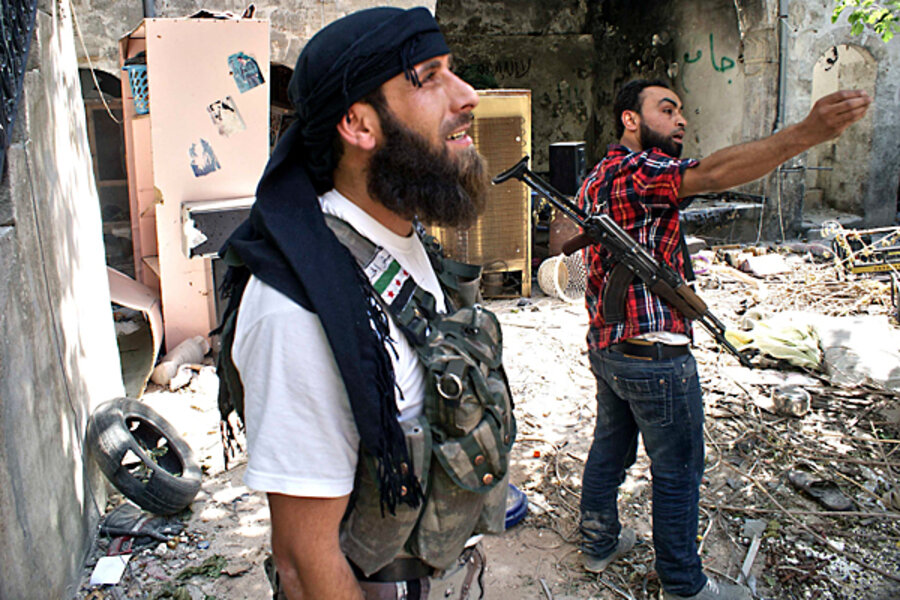How Syria's conflict became more complicated as US debated arms for rebels
Loading...
| Istanbul, Turkey
The Obama administration’s decision to begin supplying the Syrian opposition with military assistance, along with reports that American officials are also considering a no-fly zone over Syria, is bittersweet news for many opposition fighters who’ve long called for US support.
The opposition will certainly be empowered by the aid, but as the US let years elapse without intervening more strongly, it left a void that has been filled by foreign jihadist fighters and members of Hezbollah. Now, it faces not just a domestic war, but a regional proxy war with lasting implications.
“I’m am very happy, but it’s very late. Because it’s this late, it has made some radical Islamic groups,” says Farouk Atli, deputy commander of a small opposition fighting group in Aleppo.
In the last year, Syria has seen a sharp rise in the number of jihadists fighting among the opposition and sectarian tensions have grown throughout the country. Like many Syrians, Mr. Atli says this could have been avoided if the US acted faster to provide assistance.
Coming more than two years into the conflict, it’s difficult for many observers to see the US decision turning the tide for Syrian rebels. The offer of military assistance could give rebel forces enough strength to feel comfortable sitting for talks with the Assad government, but without a deeper commitment it’s unlikely to bring rebel forces closer to victory. The assistance is more likely to create something closer to a parity of forces that allows rebels to hold their ground, but still not make make significant advances.
“If the US wanted to do it, they should have done it a year ago,” says Michael Stephens, a researcher at Royal United Services Institute in Qatar. “We got into this spiral where we didn’t arm because we were worried about extremists who then got funding from the Kuwaitis and the Saudis who then got better armed and performed better and became more popular, which then gave us a reason to not arm.”
The US acknowledgement that the Assad regime has used chemical weapons inside Syria – which Obama had said would be a “red line” resulting in American involvement – was among the main factors driving the decision, but pressure had been growing for some time.
Late last month US Sen. John McCain made a trip inside Syria and met with prominent members of the Free Syrian Army at a northern border crossing. The senator has been among the most vocal champions for a greater US role in Syria, but he went on a particularly strong push after his visit.
Shortly after Mr. McCain returned to the US, rebel forces lost the key town of Qusayr, near the border of Lebanon. The fight underscored the regional spill over and growing role of Hezbollah inside Syria as the group openly sent thousands of fighters to help the Syrian government.
As late as last winter, the Syrian opposition was optimistic that it could make steady gains against government forces, but it became clear in recent months that the opposition was increasingly at risk of losing. The fall of Qusayr punctuated this point.
The fall of the Syrian opposition would be a considerable blow for the US. American officials have been extremely outspoken in their calls for Assad to step down. If he manages to regain control of the country, it will severely hinder US efforts to negotiate regional politics.
Despite the new US pledge, the relatively modest scope of the assistance to come indicates that Obama has yet to overcome his concerns about intervening decisively in another Middle Eastern conflict.
“I don’t think anybody at this phase is prepared to provide the quantity and quality of weapons that would fundamentally do enough for the opposition so they could defeat Assad or force him to the negotiation table,” says Aaron David Miller, a vice president at the Wilson Center in Washington who has advised Republican and Democratic secretaries of state on Middle East.
As it becomes apparent just how much the US will have to do to give the rebels a major advantage over Assad's forces, the Obama administration will be confronted with decisions about whether to escalate American involvement, potentially pulling the nation deeper into the conflict, Mr. Miller says.
By waiting more than two years to provide military assistance to the opposition, the US now must contend with a far more complex situation inside Syria than existed even just last summer. The proliferation of conservative groups and the emergence of groups such as Jabhat al-Nusra, whose leadership is loyal to Al Qaeda, makes it difficult to ensure that weapons will not end up in the hands of jihadists.
“If the rebels were armed a year ago, before Al Qaeda entered the battlefield, before jihadists and foreign fighters had entered the battlefield, there would have been higher hopes of providing a quicker resolution to the Syrian situation,” Islam Al Tayeb, a Middle East analyst at the International Institute for Strategic Studies.
“I don’t think that arming the rebels will increasingly and significantly change the negative consequences that the Syrian crisis is having in the region. I think it will just speed advanced, armed combat between the rebels and regime forces. It may even speed them in a way the region is not prepared to deal with yet.”






